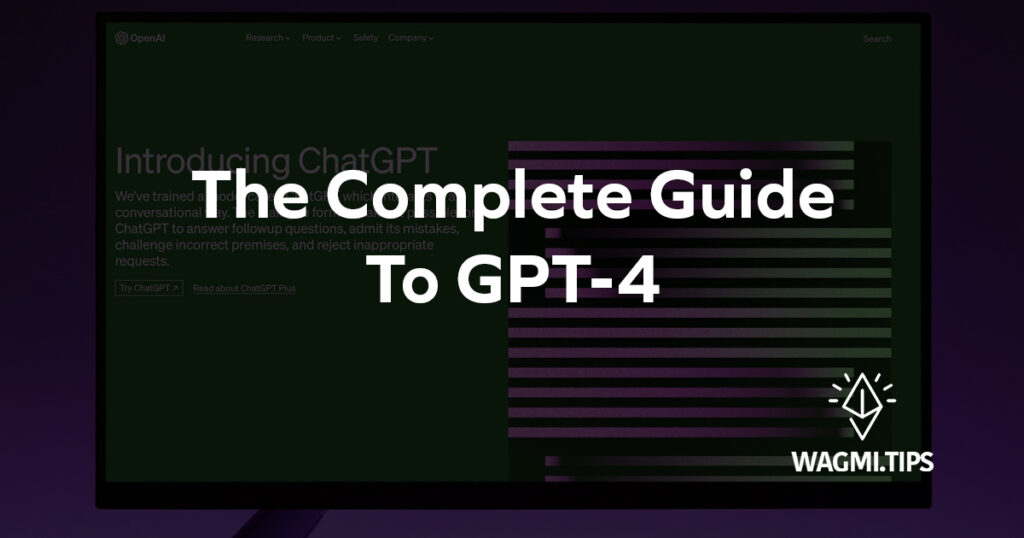The Complete Guide To GPT-4: What Is It And How To Use It
Welcome to the first of the series of future tech on Wagmi.tips. Today, we will be covering one of the hottest topics in the A.I. space, the latest and greatest version of OpenAI’s language model, GPT-4. In this blog post, we’ll explore the ins and outs of GPT-4, its features, use cases, and how it’s different from its predecessors, GPT-3.5 and ChatGPT. So grab a cup of tea, sit back, and let’s dive into the fascinating world of GPT-4!

Table of Contents
What is GPT-4?
First things first. GPT-4, or Generative Pre-trained Transformer 4, is the latest iteration of OpenAI’s revolutionary language model. Building upon the foundations of its predecessors, GPT-4 utilizes advanced machine learning techniques and an even larger dataset to generate more accurate, context-aware, and human-like text. It’s like having a knowledgeable friend who can help you with a wide range of tasks, from answering questions and writing essays to translating languages and coding.
What Are The Features of GPT-4?
Now, let’s dig a bit deeper into the features that make GPT-4 stand out from the crowd:
Bigger and better: GPT-4 boasts a significantly larger dataset and more model parameters than GPT-3.5. This means that it has been trained on a broader spectrum of information, resulting in more accurate predictions and a better understanding of context.
Enhanced context awareness: GPT-4 can understand and retain context over a longer sequence of text. This makes it better at producing coherent and relevant responses, even in complex or lengthy conversations.
Improved fine-tuning: GPT-4 offers more advanced fine-tuning capabilities, allowing developers to better tailor the model to specific tasks or industries. This results in higher quality, more customized applications.
Faster response times: Despite its size and complexity, GPT-4 is optimized for quicker response times. This makes it more practical for real-time applications like chatbots and virtual assistants.
Examples of Use Cases of GPT-4
The potential use cases of GPT-4 are vast and varied. You can use GPT-4 for a range of applications in your professional and personal tasks to make life easier. Here are just a few examples:
Content generation: From blog posts and social media updates to video scripts and ad copy, GPT-4 can help businesses create engaging and high-quality content at scale.
Customer support: GPT-4 can be integrated into chatbots or virtual assistants to provide efficient, accurate, and empathetic customer support across various industries.
Language translation: With its improved understanding of context and language nuances, GPT-4 can be a valuable tool for translating text between languages.
Coding assistance: GPT-4 can help developers by generating code snippets, offering suggestions, and even debugging code in real-time.
Education: GPT-4 can be used to create personalized learning experiences, answer student questions, and generate study materials on a wide range of subjects.
What's The Difference between GPT-4, GPT-3.5, and ChatGPT?
First, it is important to understand that ChatGPT is just a chat interface that powers the OpenAI model GPT-3, and thus is called GPT3.5. The company OpenAI just rolled out ChatGPT for model 4.0, and hence you can now use ChatGPT to interact with the GPT-4 model.
So what makes GPT-4 bigger and better than GPT3.5?
Ability to “Read” images. Perhaps the thing that stands out the most about GPT-4 is its ability the understand images. Previously you could only use text prompts to interface with ChatGPT / GPT-3. Now, you can give an image to GPT-4 and they can use it to find relevant information. For example, you can give it a picture with 2 different colored pants (red and blue) and it will tell you which is the blue pants.
Size and complexity: GPT-4 is the largest and most complex model in the series, with a substantially larger dataset and more model parameters than GPT-3.5 and ChatGPT. This makes it much smarter than the previous models.
Context awareness: GPT-4 is better at understanding and retaining context over longer conversations, making it more suitable for complex tasks. Simply put, it has much larger memory and can remember what you said to it previously way better than the previous model. It can remember 16x more than what it was capable of in previous models.
Fine-tuning: GPT-4 has improved fine-tuning capabilities, allowing for more customized and industry-specific applications.
How To Use GPT-4?
Alright, let’s get down to brass tacks. Right now, you can use GPT-4 with ChatGPT. However, it is currently available for paid ChatGPT-4 users. You can sign up for a ChatGPT account at https://chat.openai.com and subscribe to the monthly subscription of $20/month to start using GPT-4.
Summary
It seems that many big tech company and investors are pouring in money into A.I. technology, accelerating development to unprecedented levels. GPT-4 is one of such groundbreaking advancements in the field of artificial intelligence and natural language processing. Its impressive features and wide-ranging use cases open the door to limitless possibilities and have the potential to revolutionize industries across the board.
As we continue to explore and harness the capabilities of GPT-4, we can expect to see even more innovative applications and a profound impact on the way we work, learn, and communicate. The future of AI looks brighter than ever, and GPT-4 is paving the way for a new era of human-machine collaboration and understanding.
